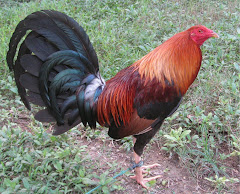Monday, June 1, 2009
Conditioning: The art of least intervention
Over-feeding and over-training can’t make
an ace out of a bum cock, but can make
a bum cock out of an ace
After you know your cock, leave him alone. Yes, do not push your cock too hard.
There was a scientific study that showed birds (gamefowl are birds) have little room in the brain for learning new tricks. They mostly act on instinct. So, you cannot teach a cock how to fight, you cannot train a cock to break high, you cannot tell the cock to shuffle hard. Just know if a cock can do any or all of these, and thus, try to naturally enhance these attributes through ample exercise, good care, right nutrition and an ideal environment.
Some cockers in an effort to dramatically improve their cocks’ performance resort to heavy table workouts. Others give their birds steroids, hormones and stimulants.
But what I learned from the masters is that no amount of feeds, additives or training can make a good cock out of a bad one. Over feeding and over training will never make an ace out of a bum cock. On the contrary, it can easily make a bum cock out of an ace.
After years of keenly observing, asking around and learning, I have formulated a cocking principle which I called the art of least intervention.
Once I find a good cock, I proceed to know it from head to toe, so to speak. I would learn what kind of body feel and in what weight it fights best. I would learn whether it loves to be well rested or it fights best when made hyper active. Then I give exactly what it wants.
In the later part of this book, you will read my pre-conditioning and conditioning methods. You will find mine simpler than most other systems.
I do not table-work my cocks. Except those with very low metabolism or those that love to be over exercised. If I do table exercises, it is only when necessary to fine tune the wing and leg muscles.
My exercises are mainly limited to rotation from tie cord to conditioning pens to fly pens to scratch box to 3x3 wire pens. In the early morning before sunrise, I do a little salida, kahig at sampi under artificial light in the sparring pit.
For overweight cocks, I put them back down the ground every time they try to perch at sundown. When they fly up the roost I place them back on the ground. When they fly again I put them down again. Five or six repetitions of this every day will help the cock lose weight.
I spar my cocks once a week, for two or three rounds every session. In sparring I put premium on developing the cocks’ alertness and focus. I do this by pitting them close, three feet apart, in the first round and allowing only two buckles or hits. In the second round I set them about six feet apart and for four buckles. I rest them for a couple of minutes and then spar them again this time far apart and for a longer period. However, I always make it a point to break them as soon as either of the cocks manages a bill hold.
As to conditioning aids, I don’t use any steroids, hormones or stimulants. I inject vitamin b complex every 15 days and give regularly other vitamin and mineral pills, directly or through their drinking water; and some electrolytes on hot days. Other than those, I rely on my regular feeds.
I love to just watch my cocks, to observe them how they are doing going through the count down to fight day. I love to watch them scratch, watch them fly, watch them walk inside the conditioning pen, and watch them gobble up all the feeds. I specially love to watch them at sunrise, when they seem to be at their best.
I don’t push my cocks. I don’t even condition my cocks. I just watch them condition themselves—this I learned from the masters; and this I call the art of least intervention.(From the book, The Edge By Rey Bajenting and Steve del Mar)
Welcome. To read the articles, please click post link or month, then subsequent post link.
Ponkan broodcock

One of the ponkan broodcocks being readied by RB Sugbo for the incoming breeding season. RB Sugbo is among the gamefowl farms very much involved in the Masang Nagmamanok (MANA) Inc. nationwide gamefowl dispersal program.
Another ponkan

Another ponkan broodcock in the trio pen.
Mana: Dami at Pagkakaisa
Walang duda napakalaki na ng pinagunlad ng sabong mula sa paging libangan tuwing araw ng Linggo, ito ngayon ay isa nang napakatanyag na isport, malaking industriya at kaakitakit na mapagkakitaan.
Napakarami nang nagpapalahi ng manok panabong. Nagsilabasan ang mga babasahin at programa sa telebisyon ukol sa sabong.
Sa bawat nagpapalahi, ilan ang tagapagalaga ng kanyang manok? Sa bawat may-ari ng sabungan, ilan ang naghahanapbuhay sa sabungan niya? Sa bawat kasali sa derby, ilan ang nagbabayad sa pinto upang manood? Sa bawat malaking sabungero, ilan ang mayroon lang iilang pirasong tinale sa kanilang bakuran? Dapat lang, at napapanahon na siguro, na ang masang sabungero ay mapagtuonan ng pansin, mabigyan ng kinatawan, at, marinig ang boses sa isport at industriya ng sabong.
Ito ang nais abutin ng MANA (Masang Nagmamanok), isang pambansang kilusan at samahan ng mga masang sabungero. Ang mga layunin ng MANA ay ang sumusunod:
1. Ang pangalagaan ang kapakanan ng mga maliit na sabungero, partikular na, ang mga naghahanapbuhay sa sabungan. Inaasam na sa darating na panahon, ang mga handlers, mananari, casador, kristos, sentensiyador, farm hands ay magkakaroon ng mga benepisyo tulad ng insurance, pension at iba pa.
2. Ang mapatingkad ang kaalaman ng ordinaryong sabungero sa pagmamanok. At, sila’y mabigyan ng pagkakataon na magkaroon ng angkop na materyales sa pagpapalahi at paglalaban.
3. Ang ipaglaban ang sabong sa gitna ng banta na itoy gawing labag sa batas tulad ng nangyari kamakailan lang sa Estados Unidos, at ipreserba ito bilang isport, hanapbuhay, industriya at bahagi ng ating kultura at tunay na mana.
4. Ang magtulungan at makipagtulungan sa iba pang haligi ng industriya sa ikabubuti ng sabong at ikauunlad ng lahat na mga sabungero.
Inaasahan na matupad ng MANA ang nasabing mga layunin pamamagitan ng pagpakita ng dami at pagkakaisa.
Ang pagkatatag ng MANA ay bunsod ng mungkahi ni kamanang Boying
Ang Llamado Tayo ay tumatalakay sa ibatibang aspeto sa pagmamanok at binabasa ng napakarami arawaraw, kaya di nagtagal marami ang sumapi sa MANA.
Kasunod nito, ang MANA ay nakapagpaseminar sa ibatibang lugar at rehiyon ng Pilipinas, sa tulong ng mga kumpaniya tulad ng Excellence Poultry & Livestock Specialist, Bmeg-Derby Ace, Sagupaan, Secret Weapon, at Thunderbird.






